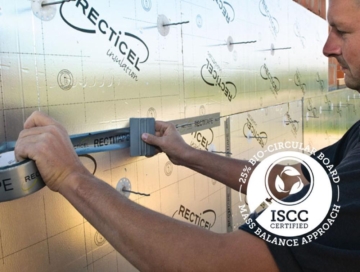Making insulation boards as carbon-neutral as possible: an approach on several fronts

Insulating may be good for reducing your emissions, but the production of insulation boards themselves is not so good for the environment.
Recticel is committed to reducing their environmental impact as much as possible. "We are committed on several fronts: replacing potentially hazardous chemicals, recycling existing products and reducing raw materials to their building blocks," explains Maxime Tavernier, sustainability engineer at Recticel.

There is no getting around it: PIR and PUR work great as insulation, but they are not ecological. The plastic foam consists mainly of three elements: MDI (methylenediphenyl diisocyanate), polyol and pentane. MDI in particular is a difficult product to get from a fully sustainable source.
1. Replacing MDI
"We have therefore been working for years to address that problem," explains sustainability engineer Maxime Tavernier. "It is not easy to replace MDI with a more sustainable alternative agent that has a similar effect. However, more and more manufacturers are coming on the market with an MDI version that already partly consists of sustainable raw materials."
Those sustainable raw materials have often already gone through a whole life cycle, like frying oil for example. "They are not yet available in large quantities, but the volume is increasing every year."
2. Circularity
"What we do have more control over is making our insulation as circular as possible," Maxime continues. "For example, the rigid insulation boards for flat roofs can be recovered at the end of the building's lifetime, provided you don't glue them together and the roof is well maintained."
This is why Recticel is betting on techniques to install the boards according to the principles of eco-design so they can be more easily detached from the rest of the structure later. "The techniques exist and our products are adapted. But the contractors who install them also have to be along for the ride. That takes time."
Whether it will ever be 100 per cent possible to recycle insulation boards? "In any case, we will make the necessary efforts to achieve recycling solutions."
3. Chemolysis
Recticel is also looking for solutions to reuse the basic chemical components. "With chemolysis, we break down the components in the rigid foam back to the basic components. That way we don't have to process new MDI and polyol each time."
4. Collecting cutting waste
On a construction site, there is also a lot of cutting waste. "On a large construction site, insulation waste can add up quickly," Maxime explains. "That's why, in collaboration with Essencia,we started a pilot project to collect waste from large construction sites. We supply big bags into which contractors throw their waste and we collect it. A specialised firm sorts the waste so it can be reused in new products."
All actions together should minimise the impact of insulation on the climate. "We have high ambitions. This is the only way to be ready for the future," Maxime added.
Latest insights & stories

ROAD SAFETY
Since 2018, the number of traffic casualties in Flanders has risen again. Currently, the figures are stagnating, but the risk of accidents with injuries remains high for vulnerable road users in Flanders. And that while traffic should be safe for all users and modes. We want to change this by focusing on transparent policy, training on safe behavior, infrastructure improvements, legislation and enforcement.

What is needed for a more circular construction sector? Insights from Sien Cornillie, Circularity expert at NAV
NAV, or "Netwerk Architecten Vlaanderen," is a professional organisation for architects in Flanders. It offers various services including professional development and advocacy for the architectural sector. NAV also fosters networking opportunities and provides advice on legal, technical, and management aspects. The network is currently working on a position paper on circularity. We sat down with Sien Cornillie, an expert on circularity and energy at NAV. This interview reflects her own opinion.

A Global Movement: The World Unites in a Pink Pledge for Clean and Sustainable Water
5,000 participants. 32 countries. €30,000 funds raised. And that's just the beginning.
Picture this: One step that sends ripples across the globe, transforming lives and creating waves of change. You might wonder, how can such a simple action for most of us have such a profound impact?